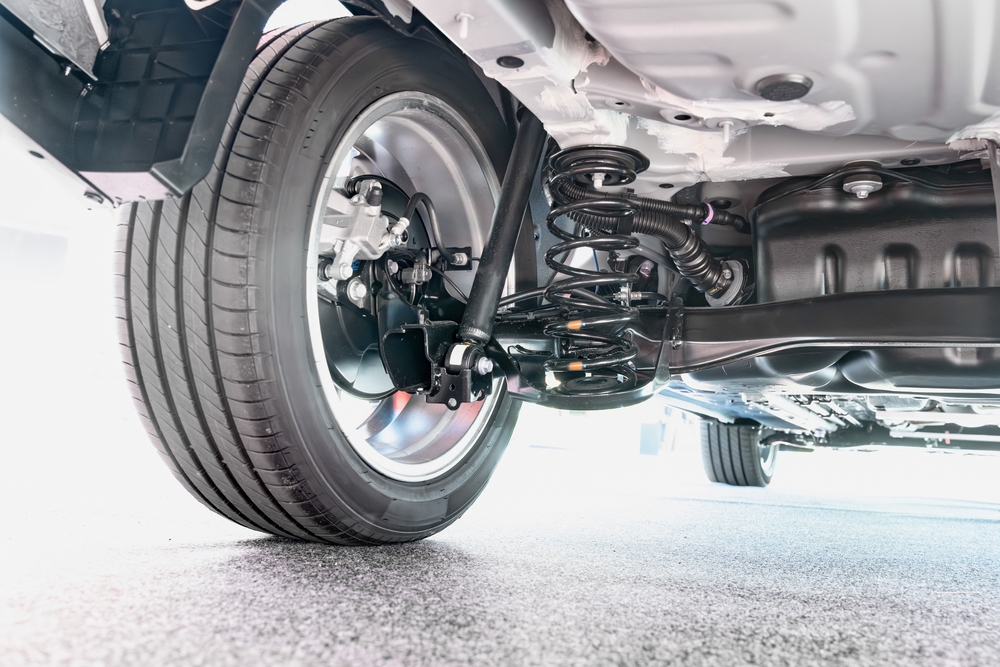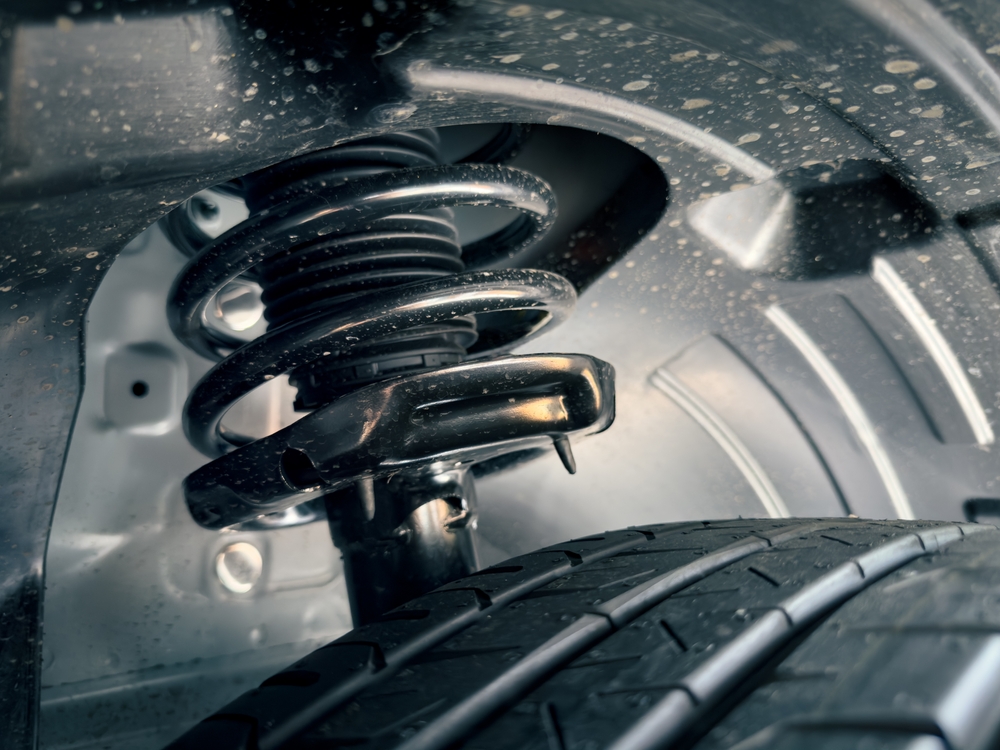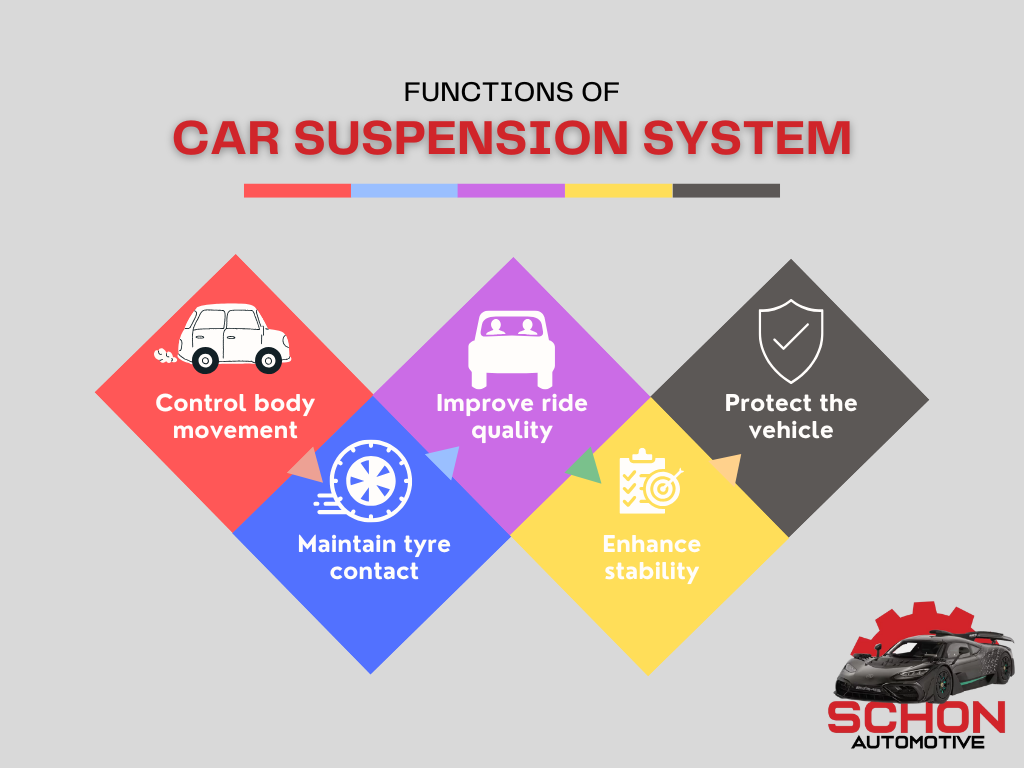Understanding Your Car Suspension Systems: How Do They Work?

Suspension is the backbone of your driving experience. It’s what keeps your tires hugging the road when you’re driving like a Fast & Furious sequel.
Every journey, be it a quick trip to the shops or a long drive through WA’s countryside, is made smoother and safer by car suspension system. The hero behind every comfortable ride, and sudden stop. It works silently beneath the surface to give you balance & control.
At Schon Automotive, we understand every component behind car performance. And your suspension system is where comfort and safety meet. Based in Perth, our team offers precision repairs and genuine care to suspension for vehicles across all makes and models.
Now, let’s lift the hood on how this mechanical marvel works.
What is Suspension System in a Car?
Carriage drivers in sixteenth-century thought a way to avoid bumps on the road. They sling the carriage body from leather straps attached to chassis on all corners. And called it a “suspension” since carriage body was suspended from the chassis.
Since then, all the buffers between road and the ride are called by this term. Today, the suspension system in automobiles consists of springs, shocks, and linkages. Its mission? To soak up the chaos of uneven terrain via:
- Supporting vehicle weight
- Absorbing energy from every pit & bump
- Keeping tyres firmly in contact with the ground
- Stabilising during acceleration, braking, and turning
That’s how, a well-designed car suspension system gives you maximum traction, effective steering, and a serene ride, even on a bumpy Aussie backroad. Plus, it also plays a role in vehicle longevity by reducing wear and tear on frame, interior, and cargo.
How Does a Car Suspension System Work?
Suspension system in automobile works by:
- Distributing the energy generated from uneven road surfaces
- Controlling how this energy moves through your vehicle
This energy management prevents the car’s body from bouncing and keeps each tyre firmly planted on the road. Good vehicle suspension systems balance three key forces:
- Compression (when the tyre moves upward).
- Rebound (when the tyre moves downward).
- Lateral force (during turns).
The suspension absorbs all these energies with springs and controls it using shock absorbers or struts. Modern systems also integrate adaptive dampers and active controls, which adjust in real time to road conditions and enhance comfort.
Suspension System Parts & Components
Sole components of car suspension incudes:
1. Springs: The First Line of Defence
Springs are the foundation of the suspension systems. Their job? Absorb the bulk of the energy from road impacts.
There are several types of springs:
- Coil Springs: Most common in modern cars.
- Leaf Springs: Found in older or heavy-duty vehicles.
- Torsion Bars: Offering a twist-type action in 4WDs.
- Air Springs: In luxury vehicles for adjustable ride height & comfort.
These springs compress when your wheel goes over a bump and expand as it comes down. So, the shock is absorbed before reaching the vehicle’s cabin.
2. Shock Absorbers (Struts or Dampers)
Shock absorbers or struts dampen the spring’s movement. So that the car doesn’t bounce after every bump. Without shocks, the energy stored in the springs would keep your car bouncing like a trampoline.
Struts, found in front-wheel-drive vehicles, combines a shock absorber with a coil spring into one unit. They play a role in both ride control and structural support. While, adaptive dampers of modern vehicles also allow adjustment to the road’s conditions.
3. Sway Bars: Stabilising the Corners
Also known as anti-roll bars, sway bars reduce body roll during turns.
When your vehicle corners, the body tends to lean outward. The sway bar connects opposite wheels and distributes the force to the inside wheel. This action keeps your car levelled and improves the cornering grip.
Types of Car Suspension Systems: Front
1. Dependent Front Suspension
In a dependent front suspension, both front wheels are connected by a solid axle. When one wheel moves, it affects the other. This setup is simple and strong but compromise the comfort and handling precision.
2. Independent Front Suspension
Most modern vehicles use independent front suspension systems.
Where each wheel reacts individually to road bumps, improving ride quality and handling. This system is lighter, reduces tyre wear, and enhances control. Hence, it is more useful in city driving and rough terrains.
Suspension Systems Types: Rear
1. Dependent Rear Suspension
Like its front-end cousin, this system connects both rear wheels with a solid axle. It’s tough and ideal for heavy loads, making it common in trucks and utes. However, it transfers more road noise and vibration to the cabin.
2. Independent Rear Suspension
This setup lets each rear wheel move independently. It gives premium ride comfort and agility, especially in high-end vehicles. You can handle road undulations better with it & maintain traction more effectively during turns.
Comparing Different Kinds of Suspension Systems
Here’s a comparison of the types of car suspension based on common vehicles:
Suspension Type | Best For | Comfort Level | Handling Precision |
MacPherson Strut | Compact vehicles | Moderate | High |
Double Wishbone | Sports cars/SUVs | High | Very High |
Multi-Link | Luxury cars | Very High | Very High |
Leaf Spring | Trucks/Utes | Low | Moderate |
Air Suspension | Luxury SUVs/Vans | Adjustable | Smooth & Refined |
Consider your vehicle, terrain & driving habits to choose the suspension for you.
Purpose & Functions A of Car Suspension
Car suspension is not just for comfort, instead it:
- Control body movement: Reduces body roll during cornering and limits forward pitch during braking.
- Improve ride quality: Absorbs the jolts from road imperfections to ensure a smoother journey.
- Maintain tyre contact: Keeps all four tyres grounded for optimal grip and braking.
- Enhance stability: Prevents swaying, nose-diving, or squatting during different driving actions.
- Protect the vehicle: Reduces wear on body panels, cargo, and interior by limiting vibration.
In essence, a well-maintained suspension auto system supports every part of your driving experience.
Why Suspension Health Should Never Be Ignored?
Even if you’re not a car enthusiast, keeping your car suspension system healthy should be on your radar. A failing system impacts everything from fuel efficiency to braking distance. It affects your safety, tyre life, and overall car longevity.
That’s why regular checks are need for every vehicle suspension system. So, your ride can stay smooth, safe, and ready for any road. Treat it well, and it’ll reward you every time you turn the key.
Need Suspension Repairs or Upgrades in Perth?
Get Pro-Level Suspension Service with Schon Automotive
Our crew at Schon Automotive in Perth specialises in car suspension systems, from inspections and repairs to upgrades and full replacements. If your car’s bouncing too much or you want a sportier feel, we’ve got the gear, skills, and passion to make it happen.
We work on every brand, Ford, Honda, Audi, Mazda, you name it. With honest pricing, quick turnaround, and expert diagnostics, we make car care easy and reliable.
Book Your Suspension Service Today
FAQs
- How often should I check my suspension system?
Once a year or every 20,000 km is a good rule of thumb. Check sooner if you notice handling issues or uneven tyre wear. - What are signs of suspension problems?
Uneven tyre wear, rough rides, noise over bumps, or a car that pulls to one side. - Can I upgrade my car’s suspension system?
Yes! From better springs to performance shocks or independent rear suspension We can help you customise for comfort or sportiness. - Is suspension repair expensive?
Costs of suspension repair vary by issue and car model. At Schon Automotive, we give honest quotes with no surprises. - What’s the difference between shocks and struts?
Shocks control spring movement; struts combine shocks with structural support.


